Affiliate disclosure: This post may contain affiliate links. Please see our Privacy Policy.
Elecampane (Inula helenium) is a perennial herb that grows wild around the world. It’d been used for generations as a flavoring and condiment, and it’s still used to make absinthe in Europe. Herbalists know it as a powerful expectorant, and harvest the roots to make herbal cough remedies.

I first read about elecampane’s traditional uses in the book Clan of the Cave Bear, a novel about a paleolithic band of humans. The wise herbalist sent a young girl out to harvest elecampane to treat coughs. I was just a young girl myself, and a budding herbalist and I dreamed of walking hillsides in an ancient time to find elecampane.
Elecampane has a history of capturing the hearts of young girls, and its Latin species name helenium comes from the story of Helen of Troy. The story goes that Helen was out gathering elecampane when she was kidnapped, and that’s the reason for the start of the trojan war.
Other stories say that elecampane sprouted from the tears she shed as she was taken. Either way, clearly I’m not the only young girl who spent a part of her youth walking along hillsides searching for elecampane.
Since elecampane prefers wet and rocky soils, I wasn’t likely to find it growing up in the desert of Southern California. On my Vermont homestead, elecampane grows on just about any forgotten corner of soil that gets ample sunlight and doesn’t get cut by my scythe.
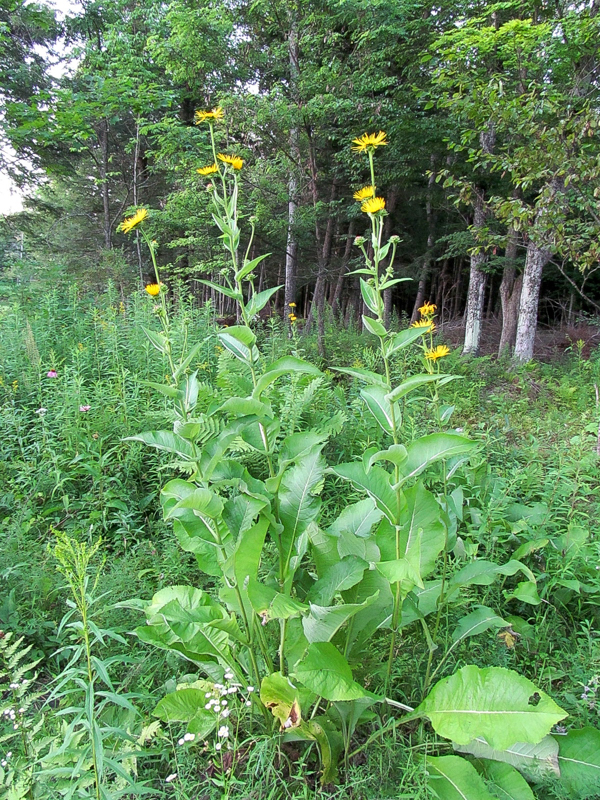
Identifying Elecampane
Elecampane is easy to identify, especially when it’s in bloom. Before the plant goes to flower it grows in a clump of large leaves about 2-3 feet tall.
The leaf form resembles horseradish a bit, with large oblong leaves coming out from a clump of dense roots below the soil.
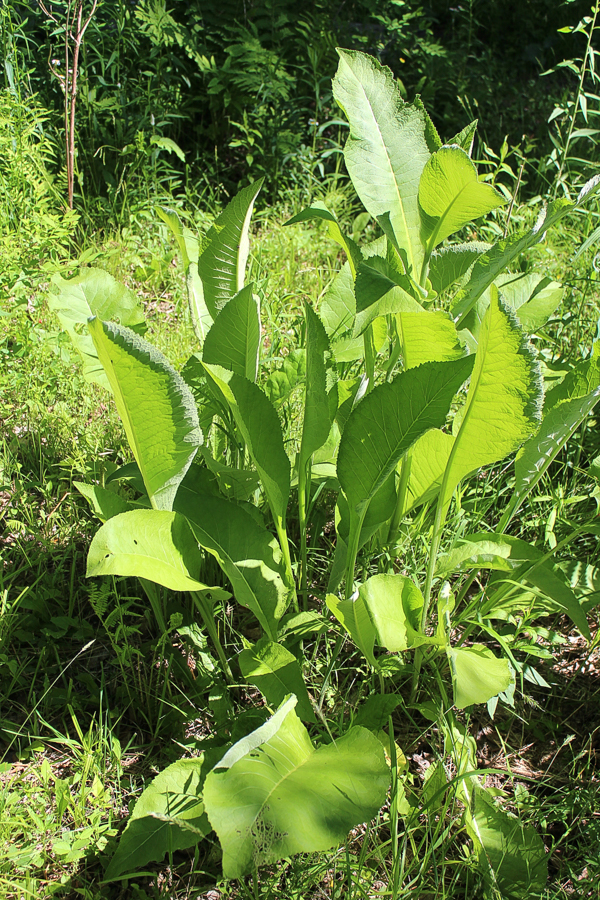
The leaves themselves have serrated edges and a distinct midrib up the center line. At their base, they taper to a thick stem that supports them from the soil.
Once elecampane sends up flower stalks, the large leaves will come out alternately from the central flower stalk, wrapping around the stem at their attachment. The leaves are lighter on the underside because they have a layer of small wooly hairs.
My Peterson field guide to medicinal plants describes the leaves as “large, burdock like, but narrower and wooly underneath.” That pretty much sums it up.
The guidebook also says that the leaves grow up to a foot long and as much as 4 inches wide, but I’ve seen them considerably bigger than that. I’d guess 16 to 18” long and 6” wide.
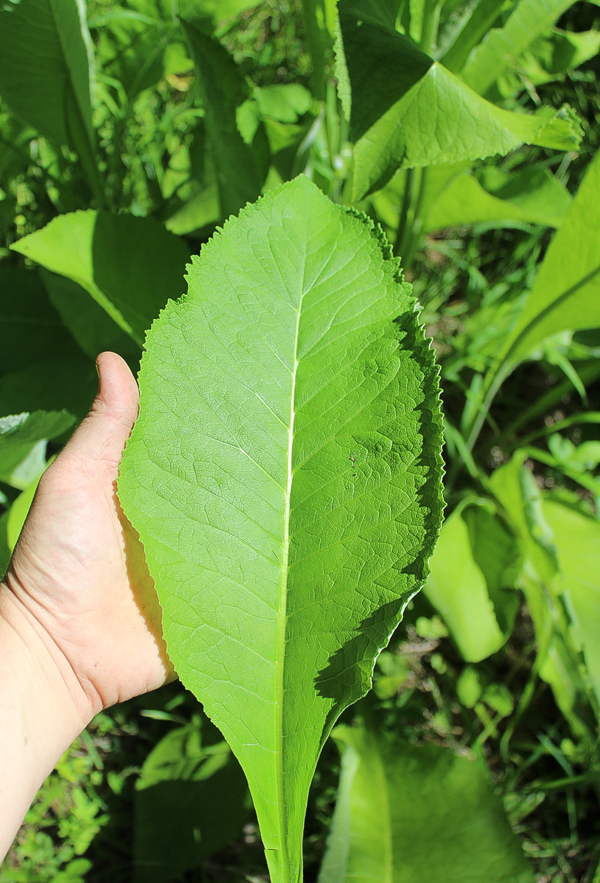
Harvesting Elecampane
Though the large leaves and yellow flowers are the showy part of elecampane, the medicine is hiding beneath the soil. Elecampane roots grow horizontally from the base of each plant, and they’re easy to harvest from the moist soil where the plant grows.
Be sure that each root is attached to the base of a plant, as it’s easy for tree roots or other roots growing nearby to get tangled up in the cluster of elecampane roots you’re harvesting.
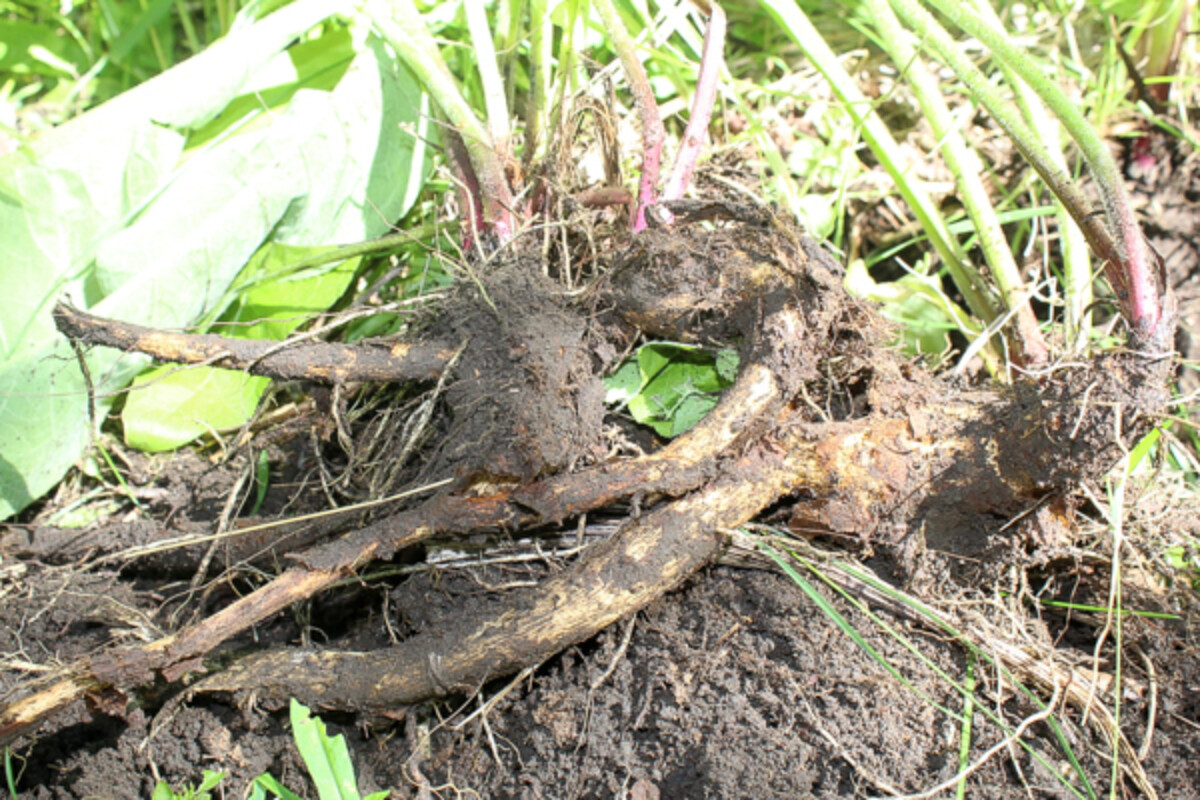
Once the roots are harvested, bring them in for cleaning and trimming.
The ones I’ve harvested are about 6 to 8 inches long and roughly 1/2 an inch in diameter.

The roots have a tough, fibrous outer layer that comes away easily with a little finger pressure.
It’s similar to the peel on a dandelion root, but it didn’t require cooking to remove. Just use a bit of thumb pressure and the peel comes right off to reveal a creamy white interior root.

Medicinal Uses of Elecampane
I’ve always known elecampane as an aromatic remedy for coughs, and it’s been used as a folk remedy for respiratory issues including whooping cough, bronchitis and asthma. It’s also used internally for stomach issues, worms and bowel issues.
The roots contain alantolactone, which is a potent natural worming compound (source). That same compound can also irritate mucous membranes and cause reactions in some people.
Studies show that elecampane extracts are helpful in treating types of bowel cancer (source) which may be due to high levels of inulin (a natural prebiotic) in the roots. Experimentally in animals, small doses lower blood sugar levels and large doses raise blood sugar levels. It’s also been shown to work as a mild sedative in mice (source).
Elecampane should be used with caution if it’s used at all. In Germany, where herbal medicines are part of the general pharmacopeia, elecampane is not generally used because it’s thought that the risks outweigh the benefits.
Elecampane can irritate the skin, and cause contact dermatitis and sensitization. Internally it can cause irritation of mucous membranes.
If you choose to use elecampane for medicine, it’s generally prepared as a tea, tincture or elecampane candy. Regardless of the use, the roots are washed, peeled and chopped.
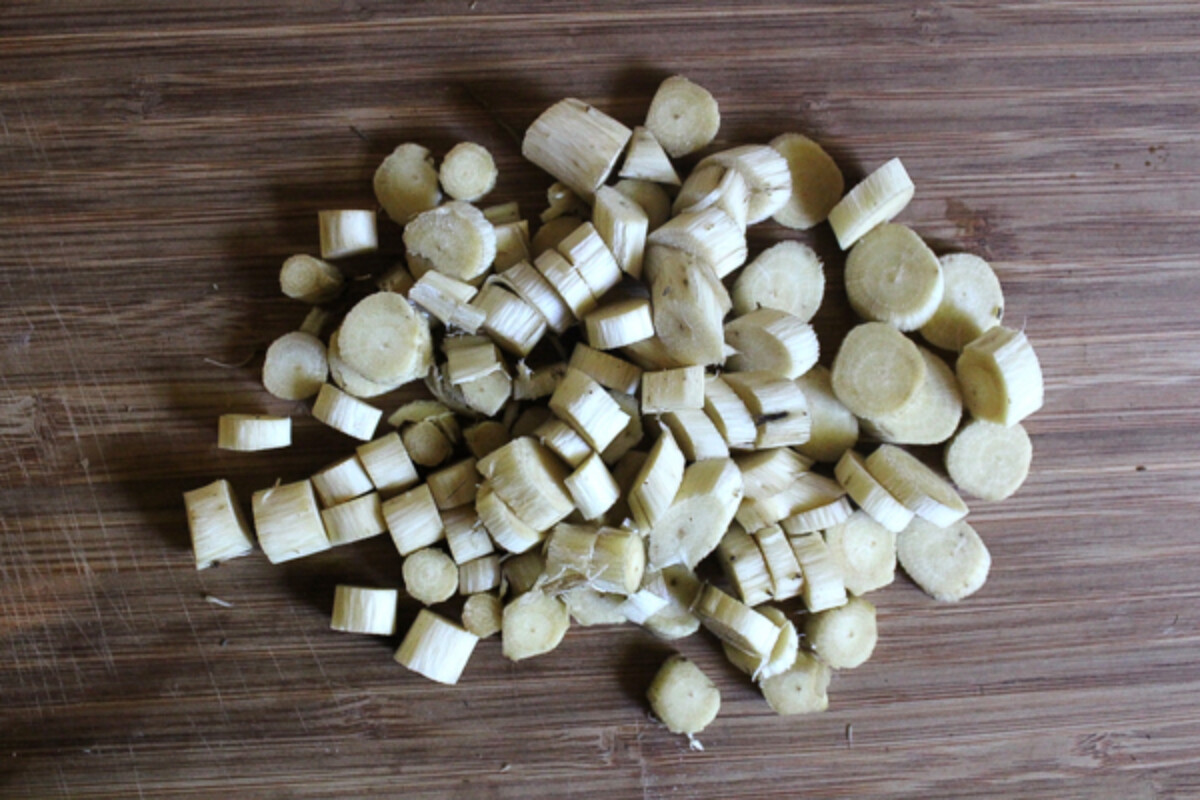
Elecampane Tea
The simplest way to prepare elecampane is as a tea. The root is boiled in water for a few minutes and then left to steep for 15 to 30 minutes. The dosage is generally 1/2 ounce of fresh root to every pint of water.
If you’re using dried root, use about half as much as with fresh. The taste is strongly medicinal, spicy and warming. It reminds me of a much more abrasive ginger, and I wasn’t happy drinking it. A more palate-friendly way to consume elecampane is as a tincture.
Elecampane Tincture
Tincturing is by far the easiest method to preserve elecampane for long-term use. The chopped root can be placed into a mason jar and covered with a neutral alcohol such as vodka.
Give it a shake every time you think about it, but otherwise, ignore it for a few months and keep it out of direct sunlight. They now make light-blocking mason jars which are perfect for homemade tinctures.
The dosage for elecampane tincture will vary from person to person, but taking small, frequent doses is recommended for treating an acute cough. Start with a small dose to see how your system responds, but generally, the elecampane tincture dosage is 30-90 drops 4 to 6 times per day. Ready-made elecampane tincture can be purchased here.

Candied Elecampane
Elecampane is also candied as a cough medicine and can be taken like candied ginger. Candied ginger is generally used for nausea, and is pretty mild and sweet according to my friends.
To my taste, it’s still too abrasive. Thus it’s no surprise that the much stronger flavor of candied elecampane was more than I could handle.
If you want to try making your own candied elecampane root, start by simmering the roots in a syrup made with 1/2 to 1 cup water and 1 cup sugar.

Other recipes online will tell you that you should weigh the elecampane and add an equal weight of sugar, then top that off with a few tablespoons of water.
When I tried it, I found that the elecampane needed to actually cook in a bit of water to soften, and a few tablespoons wasn’t enough to sufficiently soften the tough roots. Play around with it, but somewhere between 1/2 and 1 cup of water, plus 1 cup of sugar to every 2 cups of chopped roots seemed to produce the best results for me.
The end result is a softened root encased in a sugary crust.

I found candied elecampane to be spicy and overwhelming, even though the sugar helped to subdue the spice a bit. I definitely knew I was eating “medicine” and I wasn’t happy about it. That said, I don’t like candied ginger or black licorice, and many people find both of those to be quite pleasant.
If you’ve got a vicious cough, I can imagine they’d be quite soothing, but I still couldn’t handle the intensity personally. I’ll stick with tincture.



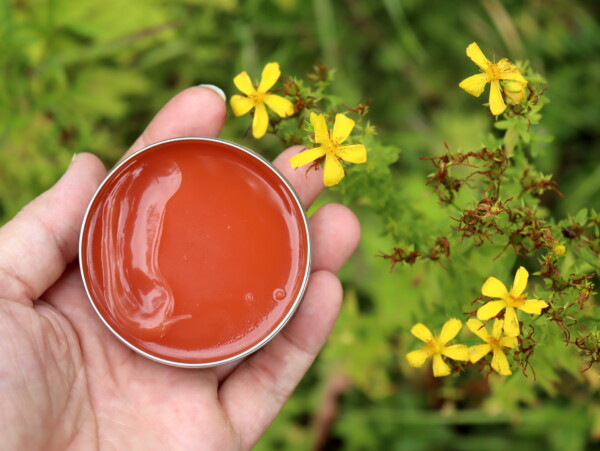
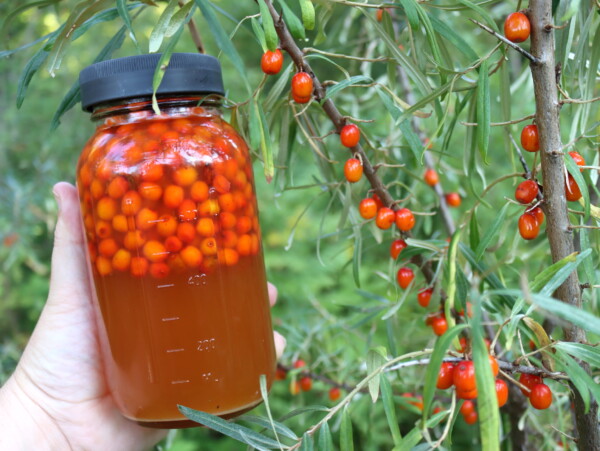










Elecampane honey is yummy, and is very effective for old coughs, in my experience. Chop the roots small and cover with liquid honey. Leave it a few weeks or months, then strain, just like making a tincture. Take 1 Tbs at a time, once or twice a day. I’ve had lingering coughs go away after 1 or 2 doses.
Hello,
I have been looking for this plant for over a year. I live in central Ohio. Where do you think I can find it? No one here seems to know.
Thanks,
Cindy
When I am unable to find plants that I want in the wild. I usually just order seeds or buy a plant and plant it in my garden.
I have been growing elecampane for a few years now. I would like to share some with the neighbor to grow, how do I give her some so she can grow it as well? Is it a root cutting or does it produce seeds?
You can propagate elecampane by cutting a healthy piece of root at least 2 inches long with at least one bud or an eye. You can plant the cutting about 12 inches deep. Elecampane can also easily be grown from seed.
Thank you! Very helpful.
Thank you for a most thorough discussion on harvesting and preparing Elecampane!